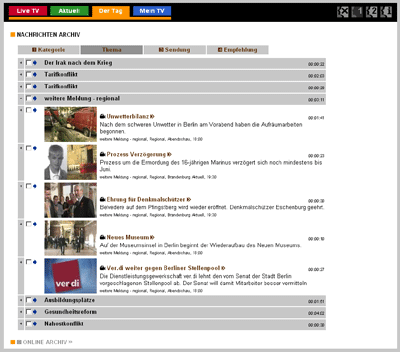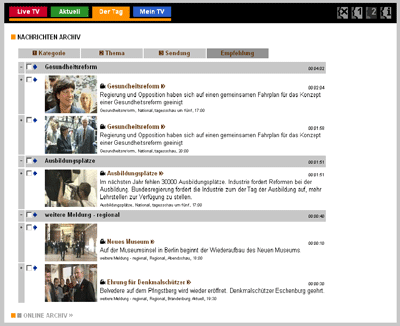
This issue in pdf Subscription Archive: Next issue: October 2005 |
| |||||||
Personalised Enriched Broadcast Experienceby Mounia Lalmas, Nick Bryan-Kinns and Alan Pearmain The SAVANT European research project developed integrated broadcast and Internet technologies, allowing users to access enriched broadcast content in an intelligent and transparent manner on a range of devices (eg TV, PC and PDA) and under varying network conditions. One aim of SAVANT was to personalise the enriched broadcast experience. Interactive digital television (iTV) is becoming widely available and is being promoted by broadcasters as a means of attracting viewers to digital TV and as an additional revenue stream. iTV provides additional services to the viewer, which enrich the broadcast experience, by including, for example, time-shifted viewing; bidirectional feedback; and additional content, from subtitles to interactive games; which all take the user's experience to a higher level than the linear, passive format of traditional TV. However, this comes at a cost. Increasing the amount of content available whilst retaining current interaction devices increases the complexity of the viewer interaction resulting in more buttons being pressed to locate additional content, and more information being crammed onto screens to show available options. Viewers could be provided with new forms of interaction devices such as personal computers, or increasingly complex remote controls. However, this would change the nature of the viewing experience from a shared, family, or social situation, to a personal tele-visual experience where one person has control, and possibly prime viewpoint. Personalisation A SAVANT screen, for the news domain, provides an alphabetical listing of content items from the daily archive, grouped under their respective topic headings Figure 1 shows how content is personalised according to user interests, which are expressed in user profiles. Personalisation is applied to the topic listings as well as the individual main and additional content items of a news story within each topic.
The personalisation system also built recommendations according to user profiles (see Figure 2). A recommendation screen only include the ranked list of content items that the user is likely to be interested in, whereas a personalisation screen include all content items, but place the user’s ‘favourites’ at the top of the list.
Implementation Users profiles were represented as a list of likes and dislikes with associated probability values reflecting the degree of interest. By examining over time the type of content that users choose to view, user profiles were created and continually maintained to reflect the changing interests of the user, by employing a relevance feedback algorithm. Information retrieval technologies were used to prioritise news items and to build recommendations. The metadata associated with news items was indexed, and this index was matched against user profiles. Matching resulted in the probability that the news item is relevant to the user profile, where the higher the probability value, the higher the news item is estimated to be of interest to the user. Evaluation Our results indicate that the recommendations were on the whole better than the semi-random generated ones, which means that appropriate recommendations were made to users. Post-feedback showed some skepticism from the participants in terms of the utility of personalised services. Participants expressed their concerns about using recommendations to structure their viewing, but were still interested in receiving such recommendations. They also indicated that personalisation may be of use when there is a lot of content available and some pre-filtering is required, but would not be appreciated if it actually selected additional possible items to view and so contributed to information overload. So, it is the filtering aspect that was seen by the participants as its key utility in their interactive TV experience. SAVANT Link: Please contact: | |||||||



